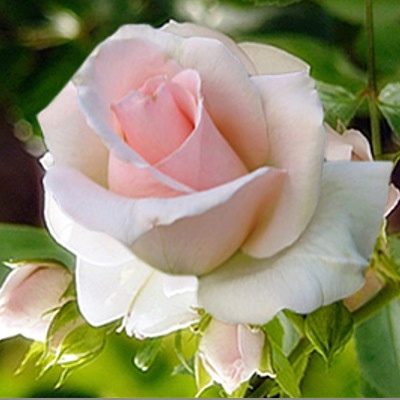
- Authors: De Ruiter Innovation BV
- Name synonyms: Vivaldi
- Breeding year: 1989
- Group: tea-hybrid
- The main color of the flower: pink
- Flower shape: cupped to flat-cupped
- Flower size: large
- Diameter, cm: 11-13
- Flower type by number of petals: medium terry
- Description of the bush: compact
If you are looking for a variety with a pleasant and delicate color for your garden, then you should pay attention to the Vivaldi rose. This plant has large flowers that will contrast favorably against the background of variegated varieties of roses or other garden plants. The variety will be an exquisite decoration for any garden, flower bed or flower arrangement.
Description of the variety
The Vivaldi variety is often grown for cutting. This is a hybrid tea rose that can be found in different parts of the country. Her buds are delicate cream in color. The opened flowers attract attention with light pink petals with a mother-of-pearl tint. The center of the flower is brighter and darker. Border color is green. The buds are ovoid, and the flowers are flat-cupped or cupped. The sizes are marked as large due to the diameter from 11 to 13 centimeters. The type of flowers is medium-sized (the number of petals is 28-35 pieces). Flowers grow singly, and only one bud is formed on each stem. The aroma of Vivaldi's rose is light and subtle.
The shrubs are compact, 60 centimeters wide and varying in height from 60 to 100 centimeters. The foliage color is standard, dark green. The outer surface of the leaves is glossy. The sizes are average. Shoots are upright. The buds grow on long peduncles.
Advantages and disadvantages
Main advantages:
- large size of flowers;
- the neat shape of the bushes;
- soft color;
- lush flowers.
Disadvantages:
- weak smell;
- only one bud grows on each shoot.
Flowering features
Flowering begins in June and lasts until September. The intensity is noted as profuse. The flowering season is uninterrupted from the first days of summer until the beginning of autumn.
Landing
Within the boundaries of the middle lane, it is advisable to plant from the end of April to the beginning of May, and in the southern regions, work is postponed to autumn. Roses are planted in the morning. Each plant is examined to remove damaged shoots and roots. Long branches are cut to 10-15 centimeters, keeping 2-4 buds. When renewing the roots, they act carefully, cutting them only to living tissue.
If the bushes are a little dry, they must be placed in clean water before planting and left for a day. It is also advisable to cover the root system with a manure or clay mash. The size of the hole for planting is 50x50 centimeters. A portion of a special mixture is laid out at the bottom, which will serve as food for the rose. To prepare the composition, you need to mix the earth and humus (compost) in equal proportions. A mound is formed from the mixture, on which the seedling is placed. The roots are gently straightened.
Growing and care
The Vivaldi variety prefers the sun, while the site must be protected from cold winds. The acidity of the soil is in the range of 5.6-7.3 pH. The soil must be drained. Water the flowers about once a week. Fertilize roses in spring and mid-summer. Two full dressings will be enough for the bushes to bloom profusely and be healthy. Resistance to precipitation is average, but frost resistance is high, while in the northern regions it is desirable to provide shelter for roses.
Bushes should be checked periodically for symptoms of disease. The diseased parts of the plant must be removed immediately to avoid further spread of the infection. If the plot chosen for cultivation does not meet the requirements, manure, peat compost or humus are introduced into it.To lower acidity, gardeners use lime or bone meal.
Pruning can be done in spring, fall, or summer. Formative pruning is done in the spring. Work begins at the end of wintering. Also, the procedure can be performed immediately before planting. In other seasons, mainly sanitary pruning is carried out. It is essential to keep plants healthy.
Reproduction
The most common breeding methods for this species are cuttings or grafting. When choosing the first option, cuttings of roses are harvested during budding. You can also get the job done after the first flowering. Shoots are carefully cut from the bush and cut into small cuttings 5-8 centimeters long. Each of them should have 2 to 3 leaves. Branches from the central part of the plant are used. The foliage must be handled carefully, since without it the cuttings will not take root.
About a day before planting (about 20 hours), the cuttings are placed in a special solution that stimulates their growth and root formation. The ends are immersed in the composition by about 1-1.5 centimeters. In horticultural stores, you can find a wide variety of ready-made preparations that are ideal for growing roses. Before planting, each stalk is rinsed with clean water. Cuttings can be planted directly in open ground or germinated first in separate containers.































































